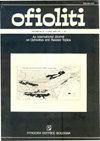反应性熔体迁移控制下洋壳的微量元素收支:来自Pineto蛇绿岩的橄榄石-橄榄石辉长岩组合的见解(法国科西嘉)
IF 1.3
4区 地球科学
Q2 GEOLOGY
引用次数: 1
摘要
Pineto辉长岩序列是一个约1.5公里厚的地壳剖面,类似于在现代缓慢扩张山脊形成洋核杂岩的地壳剖面。该序列被细分为两个扇区,显示不同的体成分。更深的部分由三长岩组成,带有少量橄榄石辉长岩和稀疏的富含橄榄石的三长岩夹层。我们对冰晶石/橄榄石辉长岩组合进行了全面的化学表征,包括矿物和大块岩石。尽管全岩成分主要受矿物比例控制,但一些微量元素(如Cr、Ni)和微量元素(例如Y、REE)的全岩变异性揭示了开放系统结晶过程的形成。这一解释得到了微量元素矿物成分的支持。不同岩石类型中斜辉石的不相容微量元素特征几乎是不可区分的,而橄榄石和斜长石显示出微量元素组成的显著变化。特别是,与三长岩中的橄榄石和斜长石相比,Ol辉长岩中的橄榄石与斜长石通常不含不相容元素。这种化学变化证明,单独的分级结晶不能确定这些岩石的成分,而是需要一个开放系统的过程,在这个过程中,熔体迁移并与预先存在的晶浆化学相互作用,导致主要元素和微量元素在整个堆积堆中重新分布。本文章由计算机程序翻译,如有差异,请以英文原文为准。
Reactive melt migration controls the trace element budget of the lower oceanic crust: insights from the troctolite-olivine gabbro association of the Pineto Ophiolite (Corsica, France)
The Pineto gabbroic sequence is a ~ 1.5 km-thick crustal section similar to those forming the oceanic core complexes at modern slow-spreading ridges. The sequence is subdivided into two sectors displaying different bulk compositions. The deeper sector consists of troctolites, with minor olivine gabbros and sparse olivine-rich troctolite intercalations. We carried out a thorough chemical characterization, including minerals and bulk rocks, of the troctolite/olivine gabbro association. Although the whole-rock compositions are mainly controlled by mineral proportions, the whole-rock variability of some minor (e.g., Cr, Ni) and trace (e.g., Y, REE) elements reveals formation by open-system crystallization processes. This interpretation is supported by the trace element mineral compositions. The incompatible trace element signature of clinopyroxene in the different rock types is nearly undistinguishable, whereas olivine and plagioclase show substantial variability of trace element compositions. In particular, olivine and plagioclase from the Ol-gabbros are typically depleted in incompatible elements compared to olivine and plagioclase from the troctolites. This chemical variability attests that fractional crystallization alone cannot have determined the compositions of these rocks, but requires an open system process where melts migrate and chemically interact with pre-existing crystal mushes leading to the redistribution of major and trace elements throughout the cumulate pile.
求助全文
通过发布文献求助,成功后即可免费获取论文全文。
去求助
来源期刊

Ofioliti
地学-地质学
CiteScore
2.40
自引率
7.70%
发文量
1
期刊介绍:
Since 1976, Ofioliti provides an international forum for original contributions and reviews in the field of the geodynamics, petrology, geochemistry, biostratigraphy, stratigraphy, tectonics and paleogeography applied to ophiolitic terrains and modern oceanic lithosphere, including their sedimentary cover. Studies of topics such as geodynamics of the mantle, the evolution of orogens including ophiolites and paleoceanography are also welcome
 求助内容:
求助内容: 应助结果提醒方式:
应助结果提醒方式:


